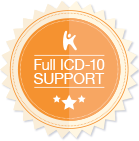CMS ICD-10 Grace Period Coming to an End
 ICD-10 has been a big change for healthcare providers. Prior to last October 1, the entire industry was investing resources in trying to be sure that the transition would be a smooth as possible. However, there were ongoing concerns about readiness from many industry groups.
ICD-10 has been a big change for healthcare providers. Prior to last October 1, the entire industry was investing resources in trying to be sure that the transition would be a smooth as possible. However, there were ongoing concerns about readiness from many industry groups.
To provide a bit of leeway, the Centers for Medicare and Medicaid (CMS) created a grace period for one year. Essentially, it allowed practices to code without worrying about getting to the highest level of specificity and use unspecific codes without being penalized. While they didn’t have a specific “grace period” many commercial payers were also more lenient during this first year of ICD-10.
A year of flexibility allowed practices that were struggling with the transition to do their best without fear of going unpaid. Luckily, all the advanced preparations and the latitude of payers made for a much smoother changeover than anyone could have predicted. Like Y2K, it went better than expected with little increase in denials and rejections.
In a couple of weeks, the ICD-10 grace period will come to an end. Healthcare providers will be expected to code to the highest level of specificity, and the use of unspecified codes will be looked at more carefully. There are certainly cases where an unspecified code may be appropriate, but if something more specific is available and there isn’t a legitimate reason for the unspecified code, the claim may be denied.
With October 1 looming, here are a few reminders on how to ensure claim accuracy with ICD-10. ![]()
- Update forms and templates to reflect ICD-10 specificity if you haven’t already. This includes patient intake forms, EHR templates, insurance forms, and superbills.
- Bring out your code maps. If you’ve been relying solely on an ICD-9 to ICD-10 crosswalk, you may not be getting to the highest level of specificity. You will likely need to create some code maps with higher specificity or have your ICD-10-CM Coding Guidelines handy so you can look codes up. Your EHR and billing software can help but ultimately to ensure the most appropriate code, you may need to do some look ups.
- Make sure everyone has adequate training to support ICD-10 coding to the highest level of specificity. Remember, the providers need to know the coding and documentation changes. If they are struggling, consider bringing in a documentation improvement specialist to help. They won’t be able to get away with not being detailed enough after October 1.
- Check with your EHR and billing software vendor to make sure they will be ready with the new and updated codes that are coming October 1 as well.
- Finally, be sure to monitor claims closely after October 1 for denials and watch for denial trends. Identify problems quickly and work to fix them. Don’t let this last ICD-10 step be a stumbling block for your practice.
Hopefully, you have spent the last year getting comfortable with ICD-10 and the specific changes that impact your specialty. If so then you should be ready for this last change. If not, now is the time to invest in some additional work and training before October 1.
If you have struggled because your software has been lacking or your biller or billing company hasn’t gotten up to speed, now is a good time to consider a change there as well. If your software isn’t what it should be now then push the button on making a change to a better solution. And if your biller isn’t getting it done, look at other options before October 1 rolls around to prevent potentially damaging revenue problems.
Check out the Kareo ICD-10 Resource Center for more information on how to be successful with ICD-10.




















